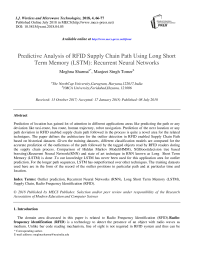Predictive analysis of RFID supply chain path using long short term memory (LSTM): recurrent neural networks
Автор: Meghna Sharma, Manjeet Singh Tomer
Журнал: International Journal of Wireless and Microwave Technologies @ijwmt
Статья в выпуске: 4 Vol.8, 2018 года.
Бесплатный доступ
Prediction of location has gained lot of attention in different applications areas like predicting the path or any deviation like taxi-route, bus route, human trajectory, robot navigation. Prediction of the next location or any path deviation in RFID enabled supply chain path followed in the process is quite a novel area for the related techniques. The paper defines the architecture for the outlier detection in RFID enabled Supply Chain Path based on historical datasets .Given the training datasets, different classification models are compared for the accurate prediction of the outlierness of the path followed by the tagged objects read by RFID readers during the supply chain process. Comparison of Hidden Markov Model(HMM), XGBoost(decision tree based boosting),Recurrent Neural Network(RNN) and state of art technique in RNN known as Long Short Term Memory (LSTM) is done .To our knowledge LSTM has never been used for this application area for outlier prediction. For the longer path sequences, LSTM has outperformed over other techniques. The training datasets used here are in the form of the record of the outlier positions in particular path and at particular time and location.
Outlier prediction, Recurrent Neural Networks (RNN), Long Short Term Memory (LSTM), Supply Chain, Radio Frequency Identification (RFID)
Короткий адрес: https://sciup.org/15016938
IDR: 15016938 | DOI: 10.5815/ijwmt.2018.04.05
Список литературы Predictive analysis of RFID supply chain path using long short term memory (LSTM): recurrent neural networks
- https://www.linkedin.com/pulse/how-epcis-rfid-changing-e2e-visibility-traceability-supply-gaethofs
- Sepp Hochreiter and Jurgen Schidhuber.Long short-term memory, Neural Comput., 9(8):1735-1780, November 1997.
- Jiang, B.; Yin, J.; Zhao, S. Characterizing the human mobility pattern in a large street network. Phys. Rev. E Stat. Nonlinear Soft Matter Phys. 2009, 80, 1711–1715. [CrossRef] [PubMed].
- Jeung, H.; Liu, Q.; Shen, H.T.; Zhou, X. A hybrid prediction model for moving objects. In Proceedings of the IEEE 24th International Conference on Data Engineering (ICDE 2008), Cancun, Mexico, 7–12 April 2008; pp. 70–79.
- Yava¸s, G.; Katsaros, D.; Ulusoy, Ö.; Manolopoulos, Y. A data mining approach for location prediction in mobile environments. Data Knowl. Eng. 2005, 54, 121–146. [CrossRef]
- Morzy, M. Mining frequent trajectories of moving objects for location prediction. In Proceedings of the International Conference on Machine Learning and Data Mining in Pattern Recognition (MLDM 2007),Leipzig, Germany, 18–20 July 2007; pp. 667–680.
- Li, Z.; Ding, B.; Han, J.; Kays, R.; Nye, P. Mining periodic behaviors for moving objects. In Proceedings of the 16th ACM SIGKDD International Conference on Knowledge Discovery and Data Mining, Washington, DC, USA, 25–28 July 2010; pp. 1099–1108.
- Li, Z.; Han, J.; Ji, M.; Tang, L.A.; Yu, Y.; Ding, B.; Lee, J.G.; Kays, R. Movemine: Mining moving object data for discovery of animal movement patterns. ACM Trans. Intell. Syst. Technol. 2011, 2, 37.
- Cheng, C.; Yang, H.; King, I.; Lyu, M.R. Fused matrix factorization with geographical and social influence inlocation-based social networks. In Proceedings of the AAAI Conference on Artificial Intelligence, Toronto, ON, Canada, 22–26 July 2012.
- Mathew, W.; Raposo, R.; Martins, B. Predicting future locations with hidden markov models. In Proceedings of the ACM Conference on Ubiquitous Computing, Pittsburgh, PA, USA, 5–8 September 2012; pp. 911–918.
- Jeung, H.; Shen, H.T.; Zhou, X. Mining Trajectory Patterns Using Hidden Markov Models; Springer: Berlin/Heidelberg, Germany, 2007; pp. 470–480.
- Alex Graves and Navdeep Jaitly.Towards end-to-end speech recognition with recurrent neural networks.In Tony Jebara and Eric P. Xing, editors,Proceedings of te 31st International Conference on Machine Learning (ICML-14),pages 1764-1772.JMLR Workshop and Conference Proceedings,2014.
- Liu, Q.;Wu, S.;Wang, L.; Tan, T. Predicting the next location: A recurrent model with spatial and temporal contexts. In Proceedings of the Thirtieth AAAI Conference on Artificial Intelligence, Phoenix, AZ, USA,12–17 February 2016; pp. 194–200.
- Hochreiter, S.; Schmidhuber, J. Long short-term memory. Neural Comput. 1997, 9, 1735–1780. [CrossRef] [PubMed]
- Hochreiter, S.; Schmidhuber, J. Long short-term memory. Neural Comput. 1997, 9, 1735–1780. [CrossRef][PubMed]
- Asif, Zaheeruddin. "Integrating the supply chain with RFID: A technical and business analysis." Communications of the Association for Information Systems 15.1 (2005): 24.
- Ilya Sutskever, Oriol Vinyals, and Quoc V. Le. Sequence to sequence learning with neural networks. CoRR, abs/1409.3215, 2014.
- Mengye Ren, Ryan Kiros, and Richard S. Zemel. Image question answering:vA visual semantic embedding model and a new dataset. CoRR,abs/1505.02074, 2015.
- https://www.openstreetmap.org/
- S.Valarmathy, R.Ramani, Fahim Akhtar, S.Selvaraju, G.Ramachandran,"Automatic Ration Material Distributions Based on GSM and RFID Technology", IJISA, vol.5, no.11, pp.47-54, 2013.DOI: 10.5815/ijisa.2013.11.05
- Arshia Zaffar, Mahnoor Gul, Rida Mumtaz, Aliya Ashraf Khan,"Development of Decision Support System for Health Care Consultation using RFID Based NFC Tags for Patient Identification", International Journal of Information Engineering and Electronic Business(IJIEEB), Vol.8, No.3, pp.20-30, 2016. DOI: 10.5815/ijieeb.2016.03.03
- Wu, Fan, et al. "A Spatial-Temporal-Semantic Neural Network Algorithm for Location Prediction on Moving Objects." Algorithms 10.2 (2017): 37.


